Key takeaways:
- Restoring vintage toys, particularly model cars, evokes nostalgia and connects individuals to their childhood memories, while preserving a piece of automotive history.
- The restoration process involves careful disassembly, cleaning, repairs, and painting, emphasizing the importance of patience and proper techniques for achieving successful results.
- Being meticulous in research and documentation enhances authenticity and improves restoration outcomes, while sharing completed projects fosters community and inspires others.
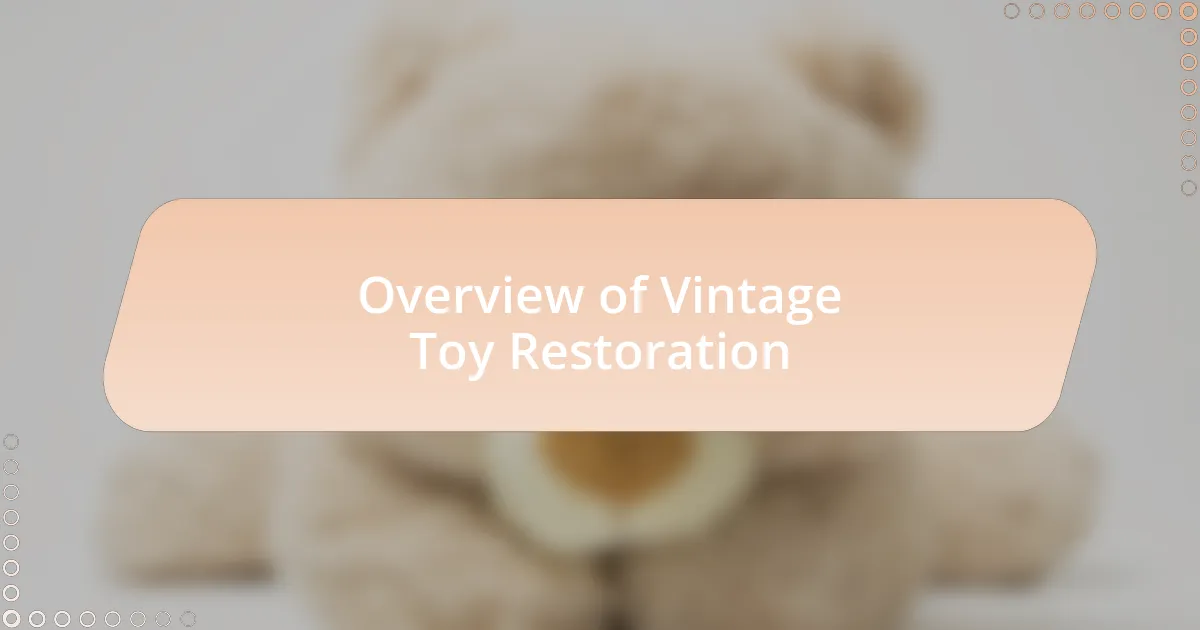
Overview of Vintage Toy Restoration
Restoring vintage toys is not just a hobby; it’s a journey into nostalgia. Each scratch or faded paint on a model car tells a story, taking me back to the moments when I first laid eyes on those miniature treasures. Have you ever held a piece of your childhood in your hands and felt that rush of joy? It’s this emotional connection that drives many of us to revive and cherish these timeless pieces.
I remember my first restoration project well—a classic, rusty Hot Wheels car my brother and I played with as kids. The thrill of stripping away the decades of wear, carefully reinstating its shine, was an experience like no other. The painstaking effort of replacing the tiny wheels and applying fresh paint brings forth not just a renewed toy, but a rekindled memory of simpler times. Can you imagine the satisfaction of seeing a cherished piece transformed back to its former glory?
In restoring vintage toys, I often find myself weighing the balance between maintaining originality and enhancing aesthetics. It’s a delicate dance: do I keep that original scratch because it adds character, or do I sand it down for a pristine finish? Each decision feels personal, as if I’m choosing how to honor the past while framing it for future generations to enjoy. Isn’t that what makes restoration so deeply rewarding?
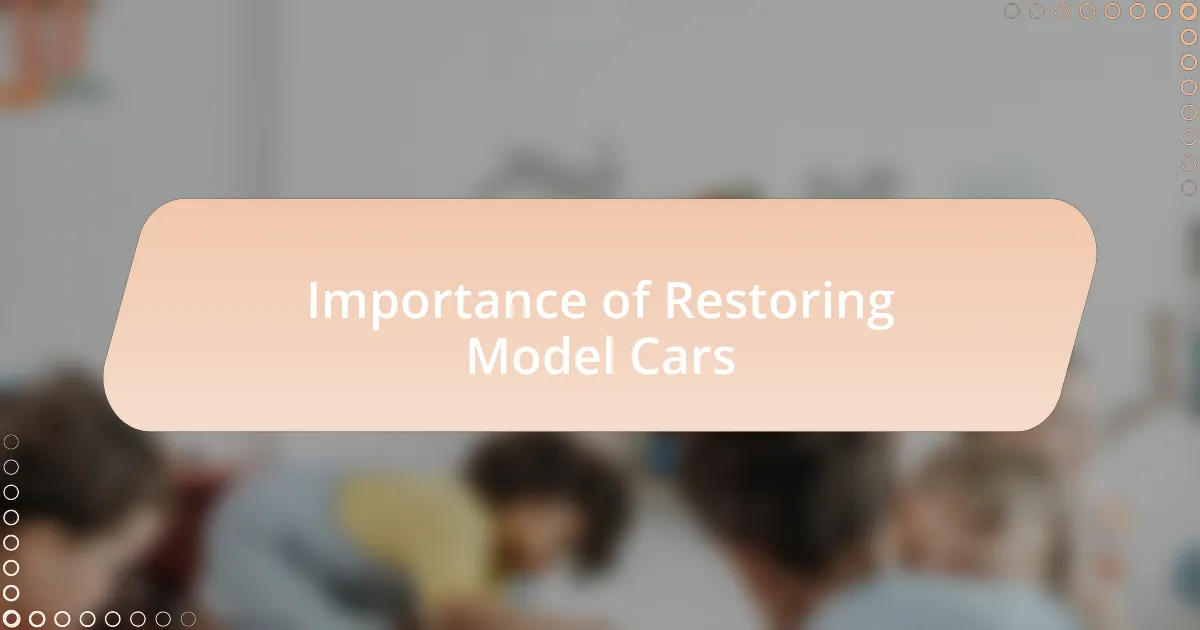
Importance of Restoring Model Cars
Restoring model cars is essential because it preserves a slice of automotive history that many forget. Each model car represents not just a vehicle, but also a moment frozen in time, reflecting the design ethos and cultural trends of its era. I recall discovering a dusty, broken-down model in a thrift store, and the excitement of imagining the stories it could tell if only it could talk. How incredible is it to think that through restoration, we can give a voice to these silent treasures?
Moreover, the act of restoring gives us a deeper appreciation for craftsmanship and engineering. I often find myself marveling at how intricate some of the designs are, down to the tiniest details. By working on these models, I’m not just fixing them; I’m learning about the artistry involved in their creation. It’s like a treasure hunt where every turn of the screwdriver reveals something new and delightful. Does that not elevate our understanding of what it means to create and appreciate art?
Finally, the community that forms around model car restoration is vibrant and supportive. When I share my completed projects online, the feedback and shared passion from fellow enthusiasts remind me that I’m part of something much larger. Have you ever felt the thrill of connecting with others over a common interest? It’s this spirit of camaraderie that makes restoration feel like a collective experience, where stories and skills are exchanged, fostering friendships that often last beyond the project itself.
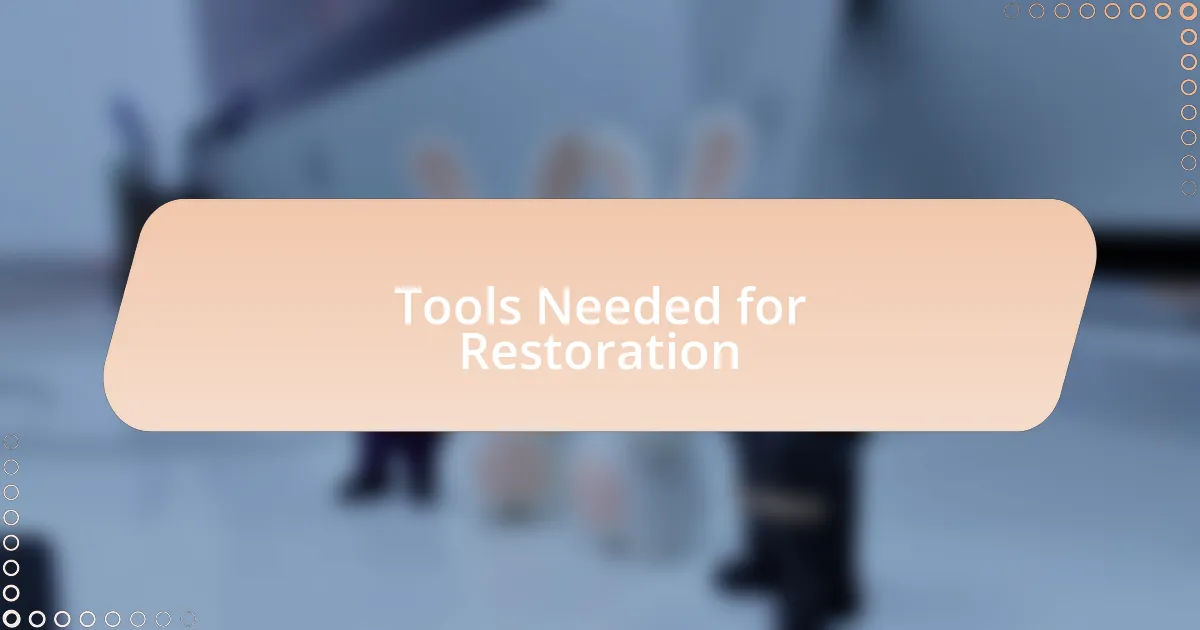
Tools Needed for Restoration
When it comes to restoring model cars, having the right tools on hand makes a world of difference. I always start with a basic toolkit that includes precision screwdrivers, pliers, and tweezers. Each time I reach for my favorite screwdriver, I remember the first model I fixed—a little fragile thing, and how those tools transformed it from a pile of parts into something truly special.
For more intricate tasks, I find that a hobby knife and sanding paper are essential. One time, I faced a particularly stubborn paint job that had chips and scratches. Armed with my knife and sandpaper, I chipped away the old layer and revealed the original color beneath. The satisfaction of seeing that gleam again was incredible—almost like unearthing a buried treasure.
Finally, while electronic restorations might not be necessary for every model, having a multimeter can be handy if you’re tuning up any vintage motors. I remember nervously using one for the first time while trying to revive a long-neglected electric model. It felt intimidating at first, but as I tested connections and learned more about how they worked, my confidence grew. It’s these moments of triumph that truly make restoration a rewarding journey.
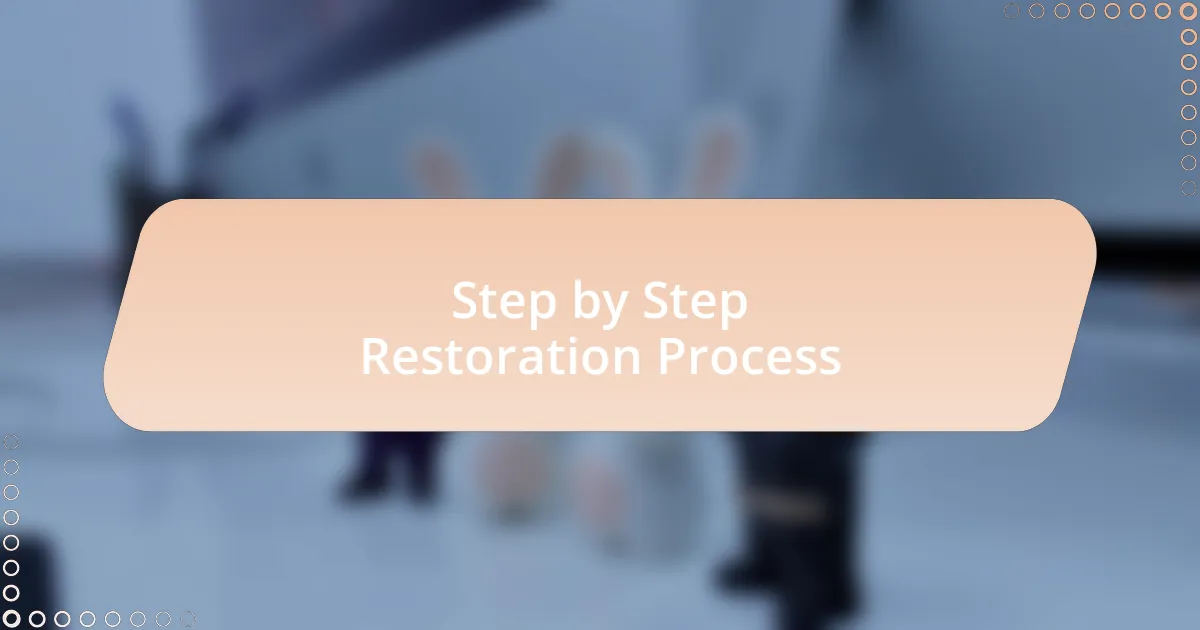
Step by Step Restoration Process
The first step in the restoration process is disassembly. I always approach this part with a mix of excitement and anxiety; will everything come apart smoothly? I carefully document each piece, often taking photos to remember how it all fits together. There’s something almost meditative about removing screws and gently lifting components away like peeling back layers of history.
Next comes the cleaning phase. I’ve found that a soft brush works wonders for getting into those hard-to-reach crevices. I remember one model that was coated in years of dust and grime. As I cleaned it, the original details reemerged, and I couldn’t help but feel a sense of connection to the craftsmanship of its creator. Does cleaning really make that much of a difference? Absolutely; it’s like wiping the slate clean, preparing for the new chapter in the model’s life.
Once everything is cleaned and inspected, I focus on repairs. I often use super glue for broken parts, but there are times when I’ve had to get creative with materials. I recall a fragile plastic bumper that needed a fix; I mixed a little epoxy and crafted a small patch. Seeing it blend seamlessly back into the model was gratifying and reinforced my belief that patience and resourcefulness are key in restoration. What will you uncover during this process? Each step reveals not only the car’s potential but also a little bit of your own history along the way.
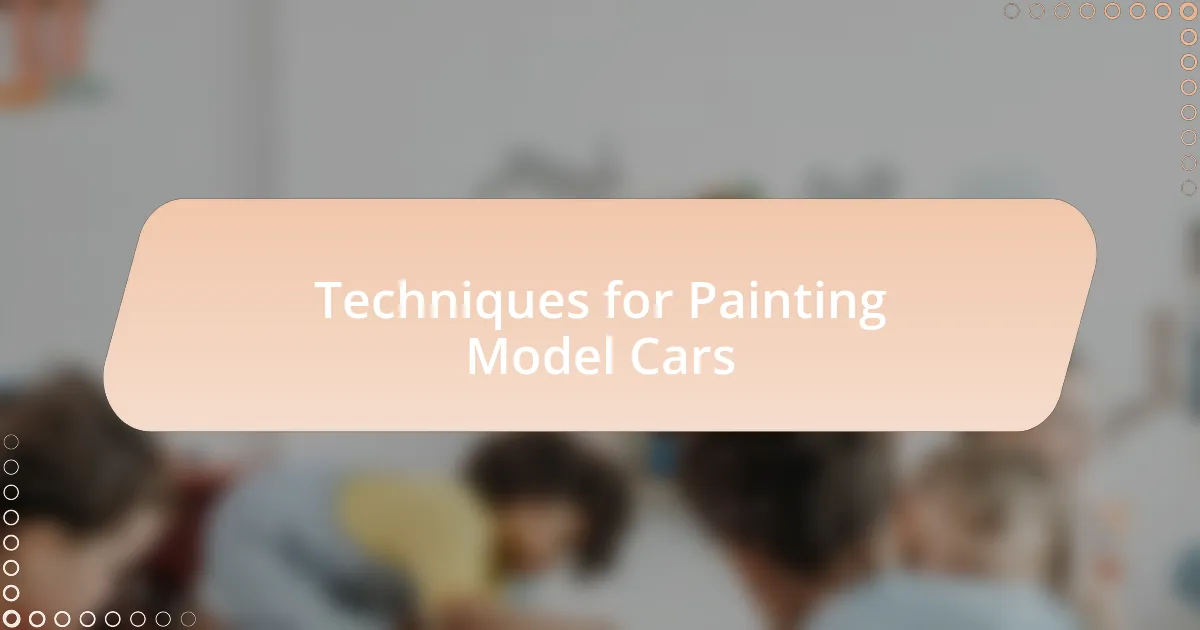
Techniques for Painting Model Cars
When it comes to painting model cars, I swear by the importance of proper surface preparation. I’ve learned that even the tiniest imperfections can show up when the paint is applied. Imagine my surprise when, during my early days of restoration, I skipped sanding and ended up with a bumpy finish! Taking the time to sand the surface lightly creates a smooth canvas that makes a world of difference in the final appearance.
For the actual painting process, I often opt for an airbrush for its fine control. A few years back, I experimented with a bright red shade for a classic muscle car. The way the paint flowed through the airbrush was mesmerizing, and applying several thin coats instead of one thick layer prevented any unsightly drips. Have you ever experienced that satisfying moment when the color truly pops? It’s like watching the car transform before your eyes, and I always feel a rush of excitement knowing that I’m just a few steps away from the final reveal.
Lastly, after the painting is done, I prioritize using a clear coat to add that glossy finish. This step not only enhances the design but also protects my hard work from scratches and chips. I vividly recall a time when I rushed this process, and the unforgiving environment of sunlight faded the paint faster than I anticipated. It taught me that patience really pays off; slow and steady wins the race in restoring these cherished models. Isn’t it incredible how the right techniques can breathe new life into what seems like a forgotten treasure?
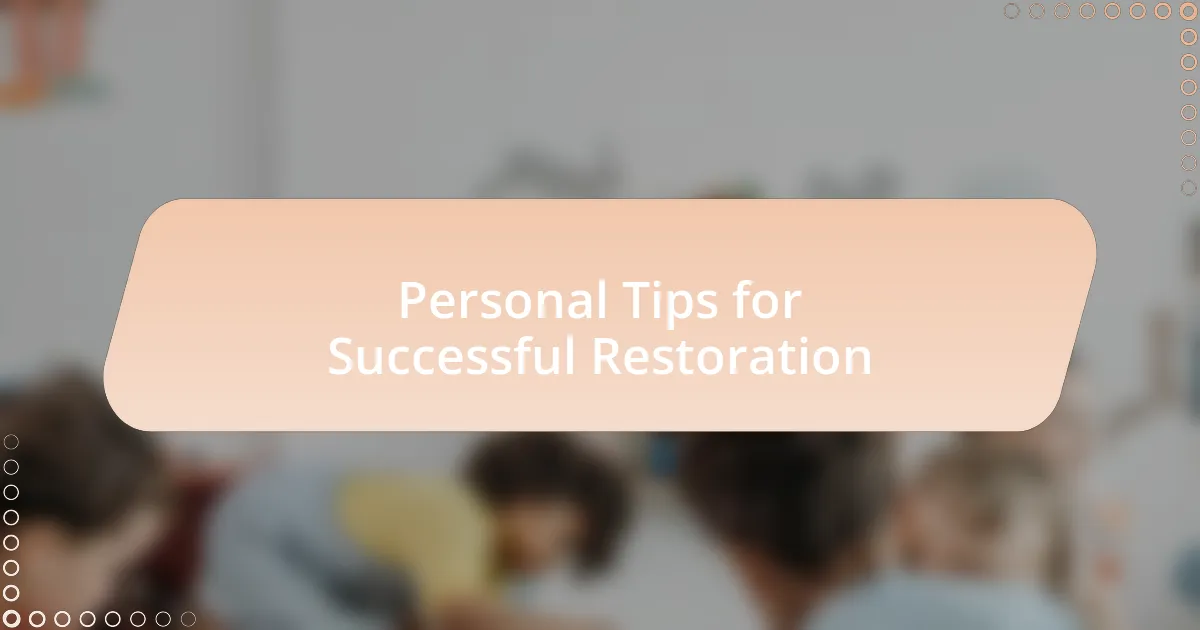
Personal Tips for Successful Restoration
When restoring old model cars, I can’t stress enough the value of researching the specific model you’re working on. One time, I dove headfirst into a restoration project without checking the history, and I ended up using the wrong color scheme. The moment I realized my mistake, I felt a mix of frustration and embarrassment, but that experience taught me that understanding the original details can significantly enhance the authenticity of your restoration.
Another tip is to take your time during the disassembly process. I remember when I hurriedly tore apart my first vintage car, thinking it would be quick. I lost a few critical parts that I struggled to replace later on. Now, I always label and organize each piece as I go, turning what used to be a chaotic mess into a manageable puzzle. Trust me, being meticulous here sets a solid foundation for the entire project.
Finally, never underestimate the importance of documenting your restoration journey. Taking photos as you progress not only serves as a timeline but also allows you to reflect on your methods and results over time. I can’t tell you how rewarding it is to look back at my earlier projects and see how much I’ve improved! Plus, it can inspire others in the hobby to embark on their own restoration adventures. How satisfying is that?

Sharing Your Restored Models
Sharing your restored models can be an incredibly fulfilling experience. I remember my first showcase at a local vintage toy fair; the moment I placed my car on the table, I felt a rush of pride. Seeing other enthusiasts admire the workmanship and share their stories was truly inspiring. Have you ever noticed how discussing a passion project can create instant connections? It’s magical.
Social media platforms are another brilliant outlet for sharing your restored models. The first time I posted my work online, I was amazed by the positive feedback from fellow car lovers. Their comments and suggestions motivated me to refine my skills even further. Have you thought about starting a dedicated page for your restorations? This not only builds a community but allows you to document your journey and watch your skills evolve over time.
Lastly, consider writing articles or blogs about your restoration process. I found storytelling to be a great way to reflect on what I’ve learned and share tips with other fans. One piece I wrote about overcoming a particularly stubborn paint issue received a lot of engagement, and some readers even shared their own struggles! Isn’t it rewarding to know that your experiences can help someone else on the same path?